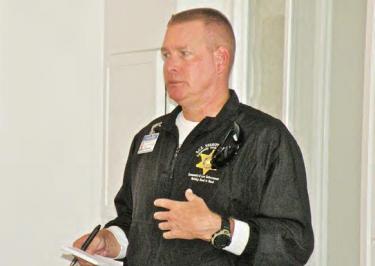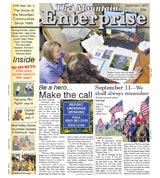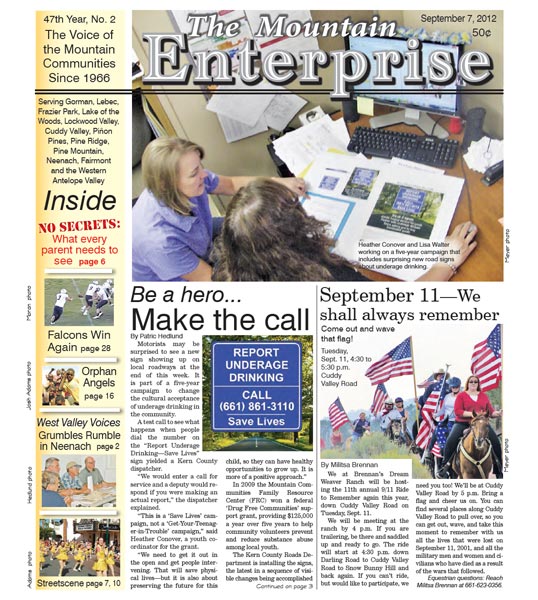
Image 1 of 5
This is the landscape that the town councils are seeking to protect, without success. Agreements made with First Solar, Inc. and Alpine Solar NRG are not being honored, residents say. Photographed on September 4, 2012 by Joanne Childers-Word in Neenach.![Oso Town Council board and members who had somber issues to cover at their meeting August 30. [Hedlund photo]](https://mountainenterprise.com/fds/images/story/fs_10788_2.jpg)
Image 2 of 5
Oso Town Council board and members who had somber issues to cover at their meeting August 30. [Hedlund photo]![Oso Town Council board and members who had somber issues to cover at their meeting August 30. [Hedlund photo]](https://mountainenterprise.com/fds/images/story/fs_10788_3.jpg)
Image 3 of 5
Oso Town Council board and members who had somber issues to cover at their meeting August 30. [Hedlund photo]![Richard Skaggs of the Oso Town Council said he received a Valley Fever diagnosis and that he believes it is far more prevalent than previously. [Hedlund photo]](https://mountainenterprise.com/fds/images/story/fs_10788_4.jpg)
Image 4 of 5
Richard Skaggs of the Oso Town Council said he received a Valley Fever diagnosis and that he believes it is far more prevalent than previously. [Hedlund photo]
Image 5 of 5
Brian Ballentine is on the advisory committee for the area to L.A. County Sheriff. He urges report of every incident, so more law enforcement resources will be allocated to the Western Antelope Valley, he says.
By Patric Hedlund
The Oso Rural Town Council came together with area residents on a windy evening August 30 to compare notes. About 27 people gathered in a meeting room adjacent to the Fairmont Market on Highway 138/ Avenue D.
They talked about broken promises and Valley Fever.
Oso’s Gerard Conroy and Richard Skaggs called the meeting to order. Current Fairmont Town Council President Barbara Rogers was there, along with the former Fairmont Council secretary, attorney David Jefferies.
It was Jefferies who filed an appeal on behalf of the Fairmont Council almost two years ago to protest the conditional use permit (CUP) issued by Los Angeles County to the Alpine NRG solar facility, allegedly without discussions with the immediate residents of the area.
In response to the threat represented by the appeal, NRG executives struck deals in private talks with Fairmont Town Council members concerning a long list of mitigations regarding landscaping, fencing, a burrowing owl preserve and funding for a nonprofit foundation to benefit community goals for the area.
Jefferies and former Fairmont Town Council President Dave Kerr told residents that the contents of the agreement would be confidential until building began on the facility. The Fairmont Council agreed to the deal.
Jefferies withdrew the appeal against the county’s CUP. The Oso Council reportedly struck a similar deal, and also agreed to a confidentiality clause until building began. So, NRG’s CUP was not challenged. Now, almost a year into building of the NRG site, council members say NRG has not complied with either of the agreements and is not responding to letters of inquiry regarding the obligations they had agreed to as mitigations.
In the meantime, Jefferies has resigned from the Fairmont Town Council and has become secretary to the nonprofit community foundation established for the Neenach community, Richard Skaggs said in his introductory comments, adding that Jefferies would be sending a demand letter to the management of NRG requiring that they honor the agreements made with the community.
Faces were grim when they turned to additional matters. Several people have tested positive for Valley Fever in the area, Skaggs said.
Valley Fever fungal spores are spread when dry soil is disturbed, and then blown by wind. “If you can inhale, you can get Valley Fever,” survivors say. People, dogs and cats are all susceptible.
The issue is of concern because Exelon’s Antelope Valley Solar Ranch 1 (AVSR1)— being built by First Solar, Inc.—extensively graded the soil on 2,100 acres to install a solar farm of 230 megawatts, (reportedly enough electricity to supply 70,000 households). Dust mitigation plans failed, and extensive dust storms engulfed the valley on windy days many times during the past year.
Barbara Rogers’ husband told this reporter about the difficulty in getting his Valley Fever diagnosed and then appropriately treated when he contracted the disease this year.
Richared Skaggs said he received a positive test result which later came back ambiguous. He said he fears there are many more cases of the dust-borne disease than are being diagnosed.
Burglaries in the area are also on the rise, but discussion at the meeting indicated that although residents talk frequently about their disdain for the response capability of the Los Angeles County Sheriff’s department to their area, that attitude also causes them not to report events.
Residents were reminded of the words of one L.A. County Sheriff’s investigator: “If you didn’t report it… it didn’t happen.”
Brian Ballentine, a 21-year resident of Neenach, is on the Citizens Advisory Committee to the Santa Clarita sheriff’s substation.
“They base their allocations of resources on numbers of calls and reports,” he explained. He said people should always call to report suspicious activities, suspicious vehicles and actual crimes (661-255-1122).
“They need to hear from you if they are going to be asked to build a case for allocating more resources out here,” Ballentine said. He invited residents to also contact him if they have concerns they wish him to take to the advisory meetings, and will distribute a special email address for that when it is available.
Another concern mentioned in the meeting was about an individual who was convicted for local thefts and sentenced to 180 days in jail, but then released within weeks, and returned to the same neighborhood to resume his activities.
Ballentine said in an interview later that compounding the early release problem are the burglars and thieves from Kern County who come across the county line to commit thefts and then take refuge back across the county line, making investigation of crimes in the Western Antelope Valley far more complicated.
Next Week: Rezoning Maps and Public Comment
This is part of the September 07, 2012 online edition of The Mountain Enterprise.
Have an opinion on this matter? We'd like to hear from you.


